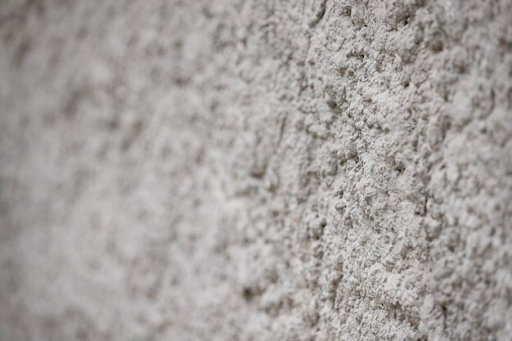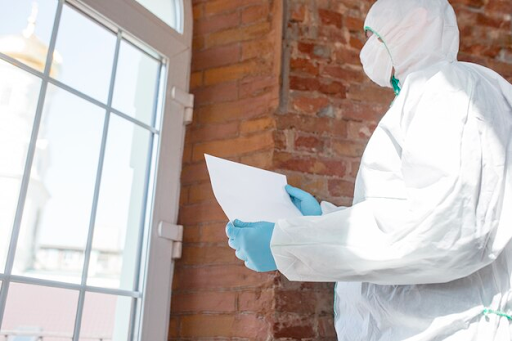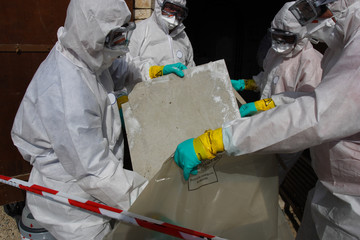Asbestos was once hailed as a miracle material, especially in the construction of older homes. Its durability and resistance to heat made it a popular choice for builders for many years. However, we now know that asbestos, particularly in the form of fibre cement products, poses significant health risks. This article is dedicated to helping homeowners and renovators understand and deal with fibre cement asbestos found in older homes.
Composition of Fibre Cement Asbestos

Fibre cement asbestos, as the name suggests, is a mixture of cement and asbestos fibers. Asbestos, known for its heat resistance and durability, was added to cement to create a stronger and more versatile construction material. This composite material offered several advantages, including fire resistance, weather resistance, and excellent insulation properties.
| Component | Percentage by Weight |
| Cement | 10-15% |
| Asbestos Fibers | 85-90% |
Recognizing Fibre Cement Asbestos
Recognizing fibre cement asbestos is crucial, especially when renovating or demolishing older buildings. Here are some key characteristics to help you identify it:
Appearance
Fibre cement asbestos often has the appearance of thick cardboard. However, it can vary depending on its application. The following are common surface finishes:
- Smooth: Some fibre cement asbestos products have a smooth, glossy surface, resembling painted wood.
- Textured: Others may have a textured or pebbled surface, which can mimic stone or stucco.
Common Locations
Fibre cement asbestos was used in various building components, primarily for its durability and fire resistance. Knowing where to look is essential for identifying potential asbestos-containing materials:
- Roof Shingles: Fibre cement asbestos was commonly used as roofing material, particularly in older homes. The shingles may have a distinctive textured appearance and may be gray or brown in color.
- Siding Panels: It was also used for siding on houses and commercial buildings. Siding made of fibre cement asbestos can have a smooth or textured finish and is often painted.
- Underlay for Flooring: In some cases, fibre cement asbestos was used as an underlay beneath flooring materials, such as linoleum or vinyl tiles. It may be hidden beneath the top flooring layer.
- Insulation: Asbestos-containing insulation was used in both residential and commercial buildings. It can be found in attics, walls, and around heating systems.
Health Risks of Asbestos
Exposure to asbestos fibers can lead to several severe health conditions, including:
Asbestosis
Asbestosis is a lung disease that gets worse over time and is caused by long-term exposure to asbestos fibers. If you breathe these tiny fibers in, they can get stuck in your lungs and cause inflammation and damage of lung tissue. These are some of the signs of asbestosis:
- Shortness of breath
- Persistent cough
- Chest pain
- Fatigue
- Clubbing of fingers (enlarged fingertips)
This condition can significantly reduce lung function and quality of life.
Lung Cancer
Exposure to asbestos significantly increases the risk of developing lung cancer. Asbestos fibers can cause genetic mutations in lung cells, leading to uncontrolled cell growth. Symptoms of asbestos-related lung cancer may include:
- Chronic cough
- Chest pain
- Unexplained weight loss
- Difficulty swallowing
- Hoarseness
Asbestos-related lung cancer is often aggressive and challenging to treat.
Mesothelioma
Mesothelioma is a rare and aggressive cancer that affects the lining of the lungs, abdomen, or heart. It is primarily associated with asbestos exposure, and its symptoms may not manifest until decades after exposure. Common mesothelioma symptoms include:
- Chest pain
- Shortness of breath
- Persistent cough
- Abdominal pain and swelling
- Unexplained weight loss
This cancer is typically diagnosed in advanced stages, making it difficult to treat successfully.
Other Health Issues
Apart from the major conditions mentioned above, asbestos exposure can also lead to:
- Asbestos Warts (Cutaneous Asbestos): Skin lesions that can develop when asbestos fibers penetrate the skin.
- Pleural Plaques: Calcified deposits on the pleura (the lining of the lungs and chest cavity), which can cause chest pain and discomfort.
- Pleural Effusion: Accumulation of fluid in the pleura, often causing breathing difficulties.
Strategies for Homeowners

Identification
Identifying asbestos in your home begins with understanding its history and common usage in buildings. Homes built before the 1980s are particularly at risk and should be the focus of your attention. A professional asbestos survey is essential for accurate identification.
- Hire a professional to conduct a thorough asbestos survey.
- Check the construction date of your home; those built before the 1980s are more likely to contain asbestos materials.
- Look for common asbestos-containing materials like insulation, tiles, and roofing.
Risk Assessment
Assessing the risk of asbestos involves considering the condition and location of the material. If asbestos-containing materials are in good condition and undisturbed, they may pose less of an immediate risk. However, ongoing monitoring and risk assessment are crucial.
- Regularly inspect the condition of any known or suspected asbestos-containing materials.
- Consider both the location and accessibility of the material to determine the likelihood of disturbance.
- Seek professional advice to understand the specific risks associated with the type of asbestos present.
Professional Removal
Removing asbestos should always be done by licensed professionals due to the high health risks involved. These experts are trained in safe removal and disposal methods and are knowledgeable about local regulations. It’s crucial to ensure that all asbestos removal is performed in compliance with these guidelines.
- Hire a licensed asbestos removalist to ensure safe and legal disposal.
- Follow all local regulations and guidelines related to asbestos handling and disposal.
- Ensure that the removalist provides a clear plan and follows strict safety protocols.
DIY Precautions
While professional removal is always recommended, if you must handle asbestos materials, take significant precautions. Avoid disturbing asbestos by sanding, drilling, or cutting into it, as this can release harmful fibers. Always use appropriate personal protective equipment to minimize exposure.
- Do not sand, drill, or cut into materials suspected of containing asbestos.
- Use appropriate Personal Protective Equipment (PPE) including respirators, gloves, and protective clothing.
- Educate yourself on safe handling procedures and consider all DIY activities as a last resort, opting for professional assessment and removal whenever possible.
Strategies For Renovators
Renovating a property can be an exciting endeavor, but it’s essential to prioritize safety and legal compliance, especially when dealing with asbestos-containing materials (ACMs). Asbestos is a hazardous mineral that can lead to severe health issues if not handled correctly. Here’s detailed information on how renovators can ensure safety and adhere to legal regulations when dealing with asbestos during renovation projects.
Understanding the Risks
Asbestos exposure can lead to serious health problems such as lung cancer, asbestosis, and mesothelioma. Renovators must understand the risks associated with asbestos and take appropriate precautions.
Personal Protective Equipment (PPE)
To minimize exposure, always wear suitable PPE when dealing with ACMs. The following table outlines essential safety gear:
| PPE Item | Description |
| Respirator | N95 or higher-rated mask for respiratory protection |
| Disposable Coveralls | Full-body coveralls to prevent skin contact |
| Disposable Gloves | Gloves made of nitrile or latex for hand protection |
| Safety Goggles | Goggles to protect eyes from asbestos particles |
| Disposable Shoe Covers | Covers to prevent tracking asbestos dust |
Local Laws and Regulations
Before starting any renovation project, it’s crucial to research and understand the local laws and regulations governing asbestos removal and disposal. These regulations may vary from one jurisdiction to another.
Asbestos Inspection
Before beginning any work on the house, renovators should perform a comprehensive asbestos examination. Finding ACMs in the structure can be made easier using this inspection. For a thorough evaluation, it’s preferable to seek the advice of an asbestos inspector or testing specialist.
Asbestos Removal and Disposal
If ACMs are identified, it’s essential to follow a strict protocol for their removal and disposal. This involves:
| Task | Description |
| Notification | Notify relevant authorities of the removal |
| Professional Removal | Hire certified asbestos removal experts |
| Proper Containment | Create an airtight containment area |
| Wetting ACMs | Dampen asbestos materials to reduce dust |
| Safe Removal | Remove ACMs without breaking or damaging |
| Waste Disposal | Dispose of asbestos waste at an approved site |
| Air Quality Testing | Conduct air tests to ensure safety |
Certified Asbestos Professionals
Renovators should never attempt to remove asbestos-containing materials without proper training and certification. Seek out professionals who are licensed to handle asbestos safely.
Consultation
It’s advisable to consult with experts, including asbestos abatement contractors, environmental consultants, and legal advisors, to ensure compliance with local regulations and safe asbestos management.
Maintenance Tips
Maintenance of asbestos-containing materials (ACMs) is crucial to prevent the release of asbestos fibers, which can pose serious health risks when inhaled. Here’s detailed maintenance tips for safely managing ACMs in your environment. By following these guidelines, you can ensure the safety of yourself and those around you.
Regular Inspection
Regularly inspecting ACMs is vital for identifying any signs of wear or damage that may lead to fiber release. Here are some key points to consider:
- Create a maintenance schedule: Establish a routine inspection schedule to ensure that ACMs are checked regularly.
- Identify suspected areas: Know where ACMs are located within your premises, such as roofing, insulation, or flooring.
- Visual inspection: Look for signs of damage, such as cracks, tears, or abrasions on the surface of ACMs.
- Record findings: Maintain a detailed record of inspection dates, locations, and the condition of ACMs to track changes over time.
- Asbestos testing: Consider periodic asbestos testing by professionals to assess the condition of ACMs accurately.
Safe Handling
When dealing with ACMs, it’s essential to follow safe handling practices to minimize the risk of asbestos exposure. Here’s how:
- Asbestos awareness: Train personnel involved in maintenance work to recognize ACMs and handle them with care.
- Personal protective equipment (PPE): Provide appropriate PPE, including respirators, disposable coveralls, gloves, and eye protection.
- Respiratory protection: Use approved respirators with HEPA filters to prevent inhalation of asbestos fibers.
- Work area isolation: Isolate the maintenance area to prevent the spread of asbestos dust to other parts of the building.
- Wet methods: Use wet methods when working with ACMs to minimize dust generation.
- Decontamination area: Set up a decontamination area for workers to safely remove PPE and clean themselves after handling ACMs.
Avoiding Drilling, Cutting, or Sanding
To prevent the release of asbestos fibers, it’s crucial to avoid activities that may disturb ACMs. Here’s what you need to know:
- Drill, cut, or sand only when necessary: Limit drilling, cutting, or sanding of ACMs to essential maintenance or repair tasks.
- Use non-abrasive methods: When possible, opt for non-abrasive methods like encapsulation or enclosure to manage ACMs.
- Professional assistance: For complex maintenance tasks involving ACMs, consult qualified asbestos removal professionals who are trained and equipped to handle such work safely.
Sealing or Covering ACMs
One effective way to prevent fiber release is by sealing or covering undamaged ACMs. Follow these guidelines:
- Sealants: Apply appropriate asbestos sealants on the surface of undamaged ACMs to encapsulate the fibers and prevent their release.
- Enclosure: Build an enclosure around ACMs, creating a barrier that isolates them from the surrounding environment.
- Warning labels: Clearly label any sealed or covered ACMs to alert maintenance personnel and prevent unintentional disturbance.
Conclusion
Dealing with fibre cement asbestos is a serious matter that requires caution and expertise. By understanding its risks, identifying its presence, and taking appropriate action, homeowners and renovators can ensure a safe living environment. Remember, when it comes to asbestos, erring on the side of caution is always the best strategy. Regular updates and compliance with local laws will keep you and your loved ones safe from the hidden dangers of fibre cement asbestos in older homes.
FAQs
Q: How can I tell if my home has fibre cement asbestos?
A: Professional testing is the most reliable method. However, homes built before the 1980s with original materials are likely candidates.
Q: Is it safe to live in a house with fibre cement asbestos?
A: Yes, if the materials are in good condition and undisturbed. Regular inspections and maintenance are crucial.
Q: Can I remove fibre cement asbestos myself?
A: It’s strongly advised to use licensed professionals due to the health risks involved in handling asbestos.
Q: What should I do if I accidentally disturb asbestos-containing materials?
A: Cease work immediately, vacate the area, and consult with asbestos removal experts.




